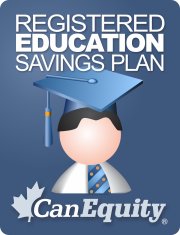Determine the Best Savings Method for your Children’s Education Savings
The Registered Education Savings Plan (RESP) is a prime method for Canadian parents or guardians to put away education savings dollars for their children or beneficiaries and watch them grow tax-free.
RESPs involve a promoter and a subscriber. A subscriber can be a parent or common-law partner, an ex-spouse or former common-law partner, or a primary caregiver. The subscriber names a beneficiary, namely the child or children to whom the education savings will in time be paid. Contributions made to the RESP cannot be deducted from income tax, but within the RESP they may grow tax-free, and be paid out to the beneficiary tax-free as well. If RESP savings are not paid out to the beneficiary by the date of contract maturity, the promoter (though which the RESP is held) will return the RESP contributions to the subscriber, and no tax will be paid on the sum at this time.
In addition to the education savings the subscriber contributes to the RESP, other education savings contributions through Government grants will also be made to the RESP. These can include education savings funds from the Canada Education Savings Grant, the Canada Learning Bond, or provincial education savings programs, such as Alberta’s Centennial Education Savings Plan Grant or Quebec’s Education Savings Incentive.
From the RESP, the promoter (the bank or other financial institution through which the RESP is administered) can allocate education savings funds from the RESP to the beneficiary to finance their post-secondary educational fees, or tuition, and make accumulated income payments.
RESPs can be made out to beneficiaries up to age 31. Should the beneficiary exceed the age limit while education savings funds are still available within the RESP named to them, the RESP can be transferred to another applicable beneficiary who is not yet 31.
There are no limits to the annual contributions one chooses to designate to their beneficiary-named RESP. However, the overall limit one can contribute to an RESP cannot exceed $50,000, though this amount does not include payments made under the Canada Education Savings Act or one of the designated provincial education savings programs.
The RESP is one of the best ways for Canadian parents or guardians to maximize their dollar potential toward education savings for their children, children in their custody, or otherwise named and applicable RESP beneficiaries. In opening your RESP while your children are young, and making contributions where you can, by the time they are ready to register for college or university courses a sizable sum will be ready to compensate their education endeavours.
To get a clearer scope of the education savings you can amass in an RESP, utilize some of the many RESP Education Savings Calculators available online. An RESP savings calculator will factor in the current balance of your RESP, the current rate of return your RESP is growing at, the current age of your child or RESP beneficiary, and the age at which they are expected to start attending post-secondary education, and give you the amount in education savings funds that they can potentially access at that point.
As holidays approach, consider Christmas and birthdays as occasions at which RESP contributions can be made as gifts, both from you and with cash from other close friends and family members. While your children are young, they may not recognize the important contribution you are making in putting away education savings into an RESP, but as they grow older and tuition costs rise, they will see that in their RESP you have made one of the best investments toward their future possible.

